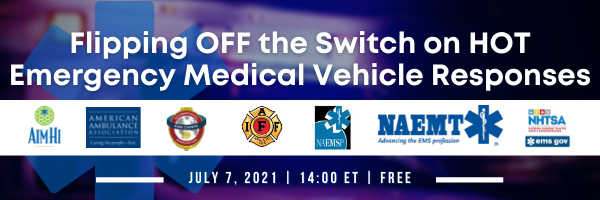FOR IMMEDIATE RELEASE: May 13, 2021
Media Contact:
Jenny Abercrombie
jabercrombie@firstwatch.net
951.440.6848
FirstWatch and the Academy of International Mobile Healthcare Integration (AIMHI) Partner to Fund the Jack Stout Archive at The National EMS Museum
Online Collection will Showcase the Late EMS Visionary’s Legacy
Carlsbad, Calif.—FirstWatch, a technology and quality improvement company serving public safety and healthcare organizations, has partnered with the Academy of International Mobile Healthcare Integration to preserve the written legacy of the late EMS visionary Jack Stout. The partnership will fund an online archive hosted by The National EMS Museum, making more than 100 of Stout’s articles and essays available to the public. Many of them appeared in JEMS, the Journal of Emergency Medical Services, beginning with his pivotal series introducing the concepts of high-performance EMS in the May 1980 edition.
As EMS Week approaches with the theme of, “This is EMS: Caring for our Communities,”
Keith Griffiths, the founding editor of JEMS and now a partner with the RedFlash Group, noted that
Stout is known for creating efficiency in EMS systems. However, his philosophy was very much about doing what was best for the patient and their community, according to their priorities and policies. Griffiths worked with Stout on dozens of his articles and columns. “He was a brilliant communicator and storyteller,” he said, “taking abstract concepts and making them come alive with clear, down-to-earth prose that still resonates today.”
Known as the “Father of High-Performance EMS and System Status Management,” Stout developed his concepts in the 1970s to improve EMS systems by making them more efficient and focused on patient care. An economist by trade, he found that applying the science, concepts, and economics used in manufacturing provided the framework for standing up high-quality EMS systems that could afford to provide effective and reliable prehospital care.
Stout’s son, FirstWatch Founder and President, Todd Stout, has granted The National EMS Museum the rights to provide access to all of his father’s articles in a format that’s fully searchable. “Teaming up with AIMHI was the natural and obvious choice to enable The National EMS Museum to ensure my father’s work, which is still so timely today, is available for future generations to learn from,” he said. “We appreciate that JEMS provided a good home for his ideas for more than a decade.”
The National EMS Museum will digitally transcribe and catalog the documents as part of its digital library and research archives—part of the virtual museum program created and maintained by volunteers. Many of the articles are already available in the museum’s online Jack Stout Archive. Additional material will be added in future months.
“We’re delighted to preserve and share these historical and transformative articles,” said Kristy Van Hoven, the museum’s director.
“AIMHI is proud to partner with FirstWatch to contribute to the creation of the Jack Stout Archive,” said Chip Decker, president of AIMHI and CEO of the Richmond Ambulance Authority. “His legacy lives on as many of our member organizations were formed around the high-performance principles and practices of Jack’s work—which is increasingly valuable in today’s economically-challenged EMS landscape.”
The principles established by Stout led to the creation (by him, Jay Fitch, and others) of nationally recognized and award-winning high-performance EMS systems including the Three Rivers Ambulance Authority (TRAA) in Fort Wayne, Indiana; the Richmond Ambulance Authority (RAA) in Richmond, Virginia; Metropolitan EMS (MEMS) in Little Rock, Arkansas; the Regional EMS Authority (REMSA) in Reno, Nevada; the EMS Authority (EMSA) in Tulsa and Oklahoma City, Oklahoma; the Sunstar system in Pinellas County, Florida; and MEDIC in Charlotte, North Carolina.
On June 24, FirstWatch will host a special edition of Conversations That Matter—a series of thought-provoking discussions in EMS—to answer the question, “Who Was Jack and Why Do His Ideas Still Resonate?” Facilitators Mike Taigman and Rob Lawrence will be joined by Kristy Van Hoven, Todd Stout, Keith Griffiths, and Jon Washko, a “Stoutian” disciple and highly respected consultant and EMS system expert, to explore why Stout’s ideas remain critically relevant for today’s EMS leader and key to the design of EMS systems of the future. Register for the session now here.
###
About FirstWatch
FirstWatch helps public safety and healthcare professionals serve their communities through the use of technology and the science of quality improvement. Drawing on deep experience in emergency services, the FirstWatch team develops software and personalized solutions to help organizations continuously improve at what they do. Founded in 1998, and based in Carlsbad, Calif., FirstWatch has partnered with more than 500 communities across North America to improve outcomes, efficiency, safety, and operations. Learn more at: https://firstwatch.net.
About the Academy of International Mobile Healthcare Integration (AIMHI)
The Academy of International Mobile Healthcare Integration (AIMHI) represents high performance emergency medical and mobile healthcare providers in the U.S. and abroad. AIMHI, formerly known as the Coalition of Advanced Emergency Medical Services (CAEMS), changed its name in March 2015 to better reflect its members’ dedication to promoting high performance ambulance and mobile integrated healthcare systems working diligently to performance and technological advancements. Member organizations are high performance systems that employ business practices from both the public and private sectors. By combining industry innovation with close government oversight, AIMHI affiliates are able to offer unsurpassed service excellence and cost efficiency. Learn more at: http://aimhi.mobi/.
About The National EMS Museum
The National EMS Museum is dedicated to preserving and commemorating the history of EMS in the U.S. By collecting historic equipment, books, articles and tools of the trade, the museum showcases how EMS has developed over the last 150 years. Through the study of the past, the museum strives to inspire EMS practitioners and leaders of today to develop new tools and procedures to provide better and more effective emergency care to patients and communities. Learn more at: https://emsmuseum.org/.


.png)







